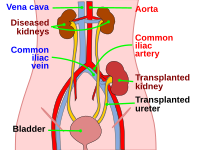
Photo from wikipedia
OBJECTIVES Urinary biomarkers and renal Doppler sonography remain considered as promising tools to distinguish transient from persistent acute kidney injury. The performance of the urinary biomarker, tissue inhibitor of metalloproteinase-2… Click to show full abstract
OBJECTIVES Urinary biomarkers and renal Doppler sonography remain considered as promising tools to distinguish transient from persistent acute kidney injury. The performance of the urinary biomarker, tissue inhibitor of metalloproteinase-2 x insulin-like growth factor-binding protein 7 and of renal resistive index to predict persistent acute kidney injury showed contradictory results. Our aim was to evaluate the performance of tissue inhibitor of metalloproteinase-2 x insulin-like growth factor-binding protein 7 and renal resistive index in predicting reversibility of acute kidney injury in critically ill patients. DESIGN Prospective observational study. SETTING Twenty-bed medical ICU in an university hospital. PATIENTS Consecutive patients with acute kidney injury. INTERVENTION None. MEASUREMENTS AND MAIN RESULTS Renal resistive index was measured within 12 hours after admission, and urinary tissue inhibitor of metalloproteinase-2 and insulin-like growth factor-binding protein 7 was measured at H0, H6, H12, and H24. Renal dysfunction reversibility was evaluated at day 3. Receiver operating characteristic curves were plotted to evaluate diagnostic performance of renal resistive index and tissue inhibitor of metalloproteinase-2 x insulin-like growth factor-binding protein 7 to predict a persistent acute kidney injury. Overall, 100 patients were included in whom 50 with persistent acute kidney injury. Renal resistive index was higher in persistent acute kidney injury group. Urinary tissue inhibitor of metalloproteinase-2 x insulin-like growth factor-binding protein 7 was not significantly different at each time between both groups. The performance of tissue inhibitor of metalloproteinase-2 x insulin-like growth factor-binding protein 7 was poor with respectively an area under the receiver operating characteristic curves of 0.57 (95% CI, 0.45-0.68), 0.58 (95% CI, 0.47-0.69), 0.61 (95% CI, 0.50-0.72), and 0.57 (95% CI, 0.46-0.68) at H0, H6, H12, and H24. The area under the receiver operating characteristic curve for renal resistive index was 0.93 (95% CI, 0.89-0.98). A renal resistive index greater than or equal to 0.685 predicting persistent acute kidney injury with 78% (95% CI, 64-88%) sensitivity and 90% (95% CI, 78-97%) specificity. CONCLUSIONS Renal resistive index had a good performance for predicting the reversibility of acute kidney injury in critically ill patients. Urinary tissue inhibitor of metalloproteinase-2 x insulin-like growth factor-binding protein 7 was unable to differentiate transient from persistent acute kidney injury.
Journal Title: Critical Care Medicine
Year Published: 2020
Link to full text (if available)
Share on Social Media: Sign Up to like & get
recommendations!